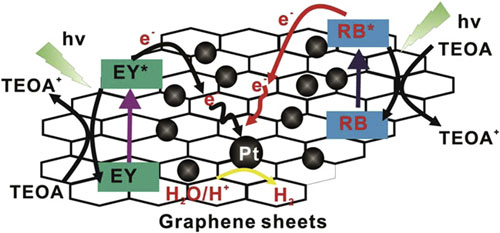Studies on dye-sensitized solar cells (DSSCs) indicated that cosensitization of TiO2 electrodes using multi-dyes exhibited significant improvement of photoelectrochemical conversion performance through enhanced light absorption by regulating dye structure and assembly of devices. However, employing dye cosensitization approach to enhance the efficiency of photocatalytic H2 evolution was seldom reported.
 |
|
The proposed photocatalytic mechanism for efficient H2evolution over EY and RB cosensitized graphene/Pt photocatalyst under visible light irradiation. |
Researchers at the State Key Laboratory for Oxo Synthesis and Selective Oxidation, Lanzhou Institute of Chemical Physics (LICP), Chinese Academy of Sciences (CAS), have successfully employed 2D graphene sheets as an efficient electron transfer carrier to construct a high performance photocatalytic H2 evolution catalyst based on the cosensitization of two dyes Eosin Y (EY) and Rose Bengal (RB). The dye-cosensitized graphene sheets with dispersed Pt catalyst exhibit higher photocatalytic activity and stability than individual dye sensitized catalysts and a high quantum yield (QY) of 37.3% has been obtained under visible light irradiation. The combinational absorption of two dyes in visible region results in an extended light response, ensuring the efficient utilization of incident light energy. The graphene sheets can greatly facilitates the electron transfer to prevent the recombination process, thus resulting in a significant enhancement in photocatalytic activity. The present study clearly shows the potential advantages of using dye cosensitization together with 2D nanomaterial can also be extended to other photosensitized systems, especially using graphene sheets as an electron acceptor and transfer carrier.
The work has received support from the National Science Foundation of China, National Program on Key Basic Research Project of China (973 Program), and Solar Energy Project of the CAS. The findings have been published in International Journal of Hydrogen Evolution(37 (2012) 10564-10574).
